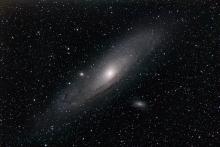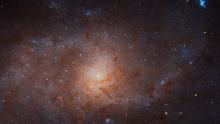Listen to today's episode of StarDate on the web the same day it airs in high-quality streaming audio without any extra ads or announcements. Choose a $8 one-month pass, or listen every day for a year for just $30.
You are here
Local Group III
Astronomers have spotted what may be the puniest galaxy ever seen. It has so few stars that it emits just 180 times as much light as the Sun. That’s a far cry from our home galaxy, the Milky Way, whose many stars produce tens of billions of times more light than the Sun.
The dim new galaxy provides insight into how the Milky Way formed. Current theory holds that giant galaxies like the Milky Way grew as lesser galaxies rammed together. But the theory predicts that hundreds or even thousands of satellite galaxies should orbit the Milky Way. So far, though, we know of only about 50.
The new galaxy is one of them. It’s about 280,000 light-years away, in Virgo, which is halfway up the southern sky at first light. Its brightest star, Spica, is just below the brilliant planet Jupiter.
The galaxy is named Virgo I. It’s just a few hundred light-years across, compared to a hundred thousand light-years for the Milky Way.
Its discovery hints that the Milky Way could have many other dim satellites. Virgo I turned up after astronomers had used the giant Subaru Telescope in Hawaii to search only a quarter of one percent of the sky. That suggests that hundreds more of these super-faint satellite galaxies orbit the Milky Way. If that many satellites are found, their discovery will lend support to the leading idea for how giant galaxies came to be.
The Milky Way may merge with another giant galaxy in the distant future; more about that tomorrow.
Script by Ken Croswell, Copyright 2016





